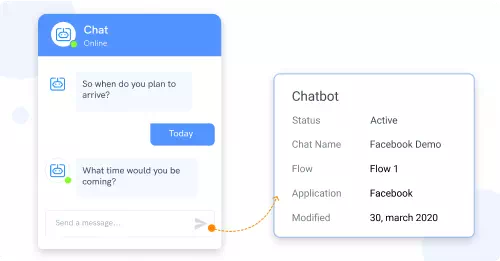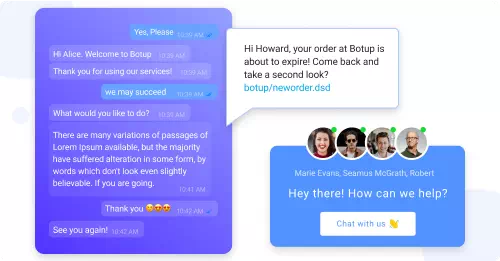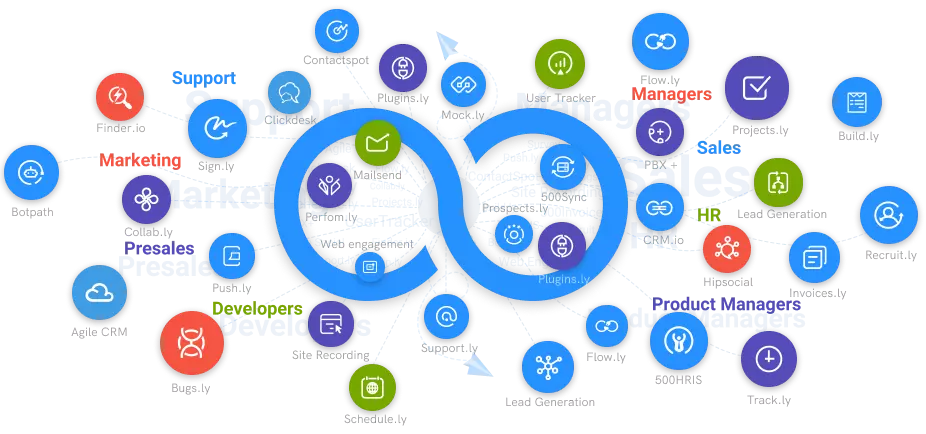What are Chatbots?
Simplify and speed up many processes for both businesses and end-users. The two main goals of a bot are helping customers find the information they need and providing a means for them to communicate directly via messaging apps.
#1
Build and improve your bot conversation flows to engage and increase leads
#2
One bot for Website, Whatsapp, Facebook, and SMS
#3
Nurture your leads faster with built-in CRM
#4
Create bots from rich & advanced template library based on your requirement
#5
Design bots using visual drag-and-drop builder with no code
#6
Use the REST step to integrate your bot flow with your database and backend
#7
Enhance service through advanced reports and revisiting customer conversation history
#8
Share appointment links, allow users to call and chat using built-in tools
#9
Unbelievable pricing - the lowest you will ever find
#10
Everything your business needs - 50 apps, 24/5 support and 99.95% uptime
Chatbots interpret communications from the user and answer based on the information it was provided by its developers. Some even learn conversation as they go. Whether you realize it or not, you have had full conversations with a chatbot while seeking customer service or sales support.
Chatbots are created to provide natural human conversation, which is why you may not be aware that you are conversing with a chatbot in certain situations, especially by text or chat messages. If you can’t tell, it’s doing its job correctly.
Two Main Chatbot Categories
Though there are several different types of chatbots, they can be categorized into two main types, including task-oriented bots and data-driven bots.
Task-oriented Chatbots
These are best described as advanced frequently asked questions (FAQ) tools. They are pre-programmed with information to respond to users as they “hear” it. Programming uses conditional statements so it learns “if” and “then” conditions to communicate appropriately.

These bots have been around for quite some time. They are often easy to recognize as bots, such as purchasing movie tickets over the phone and the more recently created food delivery ordering. As complicated as they seem, these are the simpler bot of the two categories.
Data-driven Chatbots
These bots use Artificial Intelligence (AI) to collect data, analyze it, and learn and evolve from it to provide complete and personalized conversations. The Amazon Alexa is a good example of a data-driven chatbot.
These are more complex bots with endless possibilities for the future because of their AI capabilities.
The Role of Artificial Intelligence
AI was a game-changer for the development of chatbots giving them Machine Learning (ML) capabilities so they can actually learn from experience without the input of developers.
In terms of customer service, AI has brought chatbot software from a glorified FAQ to a personable conversationalist capable of determining what type of help you need and the solution for it. In fact, AI has increased chatbot capabilities so much that it can actually provide therapy to support mental health!
Why Use Chatbots?
Chatbots are proving to be invaluable in the mobile age as organizations are expected to provide better and better customer service in order to compete with all the other organizations that are available to your prospects at the swipe of a phone screen. On top of that, consumers are finding online or automated customer service to be more convenient so they don’t have to wait on hold for the next available representative.
Evolution of Chatbots
Originally, chatbots were used to simulate humans in order for us to learn from them, in fields such as psychiatry or to test their ability to intelligently think like humans. Some of the original technology from nearly 50 years ago was successful and is still in use today!
The use of AI chatbot evolved considerably with Apple’s Siri creation. Apple introduced the conversational AI assistant that spurred several others, like Google Assistant and Microsoft Cortana, making them more useful as a voice-commanded device that can answer questions, play music, set alarms, and so much more. This led to even more sophisticated smart speakers such as Amazon Alexa and Google Home.
Social media has also become a very popular use for chatbots. For instance, implementing a Facebook chatbot is an extremely effective way to interact with customers and prospects about your products and your brand.
Benefits of Chatbots
Chatbots offer numerous benefits to businesses and consumers alike. For businesses, chatbots have offered a new layer of customer service that can save significant time and money. It saves time for customer service and sales employees since it can be the first communication with prospects or customers. The bot will respond immediately, which is of utmost importance to customers and allows reps to avoid having to drop everything to take a call or message.
The chatbot will then ask the appropriate questions to determine exactly what the issue is and give appropriate answers, if possible. If it can’t answer the question or resolve the issue itself, it will determine who the best human customer service or sales representative is to field the query.

Customer service chatbot will save money for organizations as it will help alleviate some of the workloads of representatives and may even alleviate the need to hire more support staff.
Possible Challenges for Chatbots
Ultimately, there really aren’t any disadvantages to chatbots. However, you may encounter challenges if you have a customer that has trust issues with technology. Ensuring they are able to reach a human will minimize this risk. Another challenge could arise if there are too many queries that the chatbot cannot field. Being able to send the caller/chatter to a human at any point will also help alleviate this possibility.
How Are Chatbots Created?
Building a chatbot can be thought of as writing a story. In its simplest terms, here is how it’s done:
- Determine what it is that you want your chatbot to do.
- Determine what steps your bot will take to get there and what options may occur during the interaction.
- Design the flow of your chatbot. Choosing from templates is a good way to start this process.
- Determine which platforms you’ll want to integrate them with.
- Integrate your chatbots.
Of course, there’s more to it than that and not everyone has experience with coding and development. Initiating the process with software such as Botup will make creating chatflows and integrating with platforms much easier. Plus, it provides reports to give you the data you need to optimize your bots.
Chatbots are basically time and money-saving assistants for your business that can help you with your customer service workload and convert your prospects faster. That’s a valuable addition to most organizations.





